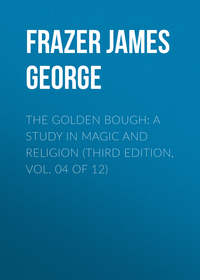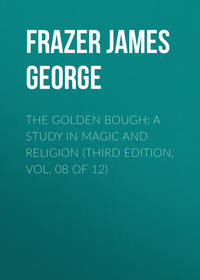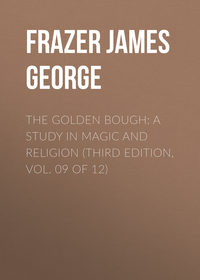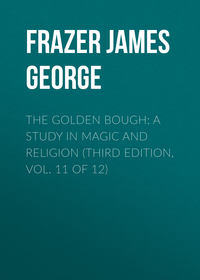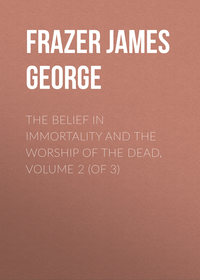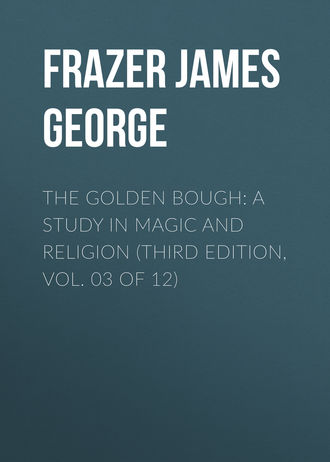 полная версия
полная версияThe Golden Bough: A Study in Magic and Religion (Third Edition, Vol. 03 of 12)
1235
O. Schellong, “Über Familienleben und Gebräuche der Papuas der Umgebung von Finschhafen,” Zeitschrift für Ethnologie, xxi. (1889) p. 12. Compare M. Krieger, Neu Guinea (Berlin, 1899), p. 172.
1236
Th. J. F. van Hasselt, “Gebruik van vermomde Taal door de Nufooren,” Tijdschrift voor Indische Taal- Land- en Volkenkunde, xlv. (1902) p. 279. The Nufoors are a Papuan tribe on Doreh Bay, in Dutch New Guinea. See id., in Tijdschrift voor Indische Taal- Land- en Volkenkunde, xlvi. (1903) p. 287.
1237
J. Graf Pfeil, Studien und Beobachtungen aus der Südsee (Brunswick, 1899), p. 78; P. A. Kleintitschen, Die Küstenbewohner der Gazellehalbinsel (Hiltrup bei Münster, preface dated Christmas, 1906), pp. 237 sq.
1238
J. Macdonald, “Manners, Customs, Superstitions, and Religions of South African Tribes,” Journal of the Anthropological Institute, xx. (1891) p. 131.
1239
V. L. Cameron, Across Africa (London, 1877), ii. 61.
1240
S. L. Hinde and H. Hinde, The Last of the Masai (London, 1901), pp. 48 sq. Compare Sir H. Johnston, The Uganda Protectorate (London, 1902), ii. 826 sq.; M. Merker, Die Masai (Berlin, 1904), p. 56.
1241
P. Reichard, “Die Wanjamuesi,” Zeitschrift der Gesellschaft für Erdkunde zu Berlin, xxiv. (1889) p. 258.
1242
J. Roscoe, “Further Notes on the Manners and Customs of the Baganda,” Journal of the Anthropological Institute, xxxii. (1902) p. 29.
1243
E. Torday and T. A. Joyce, “Note on the Southern Ba-Mbala,” Man, vii. (1907) p. 81.
1244
A. C. Hollis, The Nandi, p. 43.
1245
Rev. J. H. Weeks, “Anthropological Notes on the Bangala of the Upper Congo River,” Journal of the Anthropological Institute, xxxix. (1909) pp. 128, 459.
1246
R. Parkinson, Dreissig Jahre in der Südsee, p. 198.
1247
Dudley Kidd, Savage Childhood, p. 73.
1248
E. M. Curr, The Australian Race, iii. 545. Similarly among the Dacotas “there is no secrecy in children's names, but when they grow up there is a secrecy in men's names” (H. R. Schoolcraft, Indian Tribes, iii. 240).
1249
Th. J. F. van Hasselt, “Gebruik van vermomde Taal door de Nufooren,” Tijdschrift voor Indische Taal- Land- en Volkenkunde, xlv. (1902) p. 278.
1250
A. C. Kruijt, “Een en ander aangaande het geestelijk en maatschappelijk leven van den Poso-Alfoer,” Mededeelingen van wege het Nederlandsche Zendelinggenootschap, xl. (1896) pp. 273 sqq.
1251
G. Mansveld (Kontroleur van Nias), “Iets over de namen en Galars onder de Maleijers in de Padangsche Bovenlanden, bepaaldelijk in noordelijk Agam,” Tijdschrift voor Indische Taal- Land- en Volkenkunde, xxiii. (1876) pp. 443, 449.
1252
Spenser St. John, Life in the Forests of the Far East,2 i. 208.
1253
Dudley Kidd, The Essential Kafir, p. 202.
1254
L. A. Waddell, “The Tribes of the Brahmapootra Valley,” Journal of the Asiatic Society of Bengal, lxix. part iii. (1901) pp. 52, 69, compare 46.
1255
H. Callaway, Religious System of the Amazulu, part iii. p. 316, note.
1256
W. Crooke, Popular Religion and Folk-lore of Northern India (Westminster, 1896), ii. 5 sq. Compare id., Tribes and Castes of the North-Western Provinces and Oudh, ii. 251.
1257
G. A. Wilken, Handleiding voor de vergelijkende Volkenkunde van Nederlandsch-Indië, pp. 216-219; E. B. Tylor, “On a Method of Investigating the Developement of Institutions,” Journal of the Anthropological Institute, xviii. (1889) pp. 248-250 (who refers to a series of papers by G. A. Wilken, “Over de primitieve vormen van het huwelijk,” published in Indische Gids, 1880, etc., which I have not seen). Wilken's theory is rejected by Mr. A. C. Kruijt (l. c.), who explains the custom by the fear of attracting the attention of evil spirits to the person named. Other explanations are suggested by Mr. J. H. F. Kohlbrugge (“Naamgeving in Insulinde,” Bijdragen tot de Taal- Land- en Volkenkunde van Nederlandsch-Indië, lii. (1901) pp. 160-170), and by Mr. E. Crawley (The Mystic Rose, London, 1902, pp. 428-433).
1258
For evidence of the custom of naming parents after their children in Australia, see E. J. Eyre, Journals of Expeditions of Discovery into Central Australia (London, 1845), ii. 325 sq.: in Sumatra, see W. Marsden, History of Sumatra, p. 286; Baron van Hoëvell, “Iets over 't oorlogvoeren der Batta's,” Tijdschrift voor Nederlandsch-Indië, N.S. vii. (1878) p. 436, note; A. L. van Hasselt, Volksbeschrijving van Midden-Sumatra, p. 274: in Nias, see J. T. Nieuwenhuisen en H. C. B. von Rosenberg, Verslag omtrent het eiland Nias, p. 28 (Verhandelingen van het Bataviaasch Genootschap van Kunsten en Wetenschappen, xxx. Batavia, 1863): in Java, see P. J. Veth, Java, i. (Haarlem, 1875) p. 642; J. H. F. Kohlbrugge, “Die Tenggeresen, ein alter Javanischen Volksstamm,” Bijdragen tot de Taal- Land- en Volkenkunde van Nederlandsch-Indië, liii. (1901) p. 121; in Borneo, see C. Hupe, “Korte Verhandeling over de Godsdienst, Zeden, enz. der Dajakkers,” Tijdschrift voor Neêrlands Indië, 1846, dl. iii. p. 249; H. Low, Sarawak, p. 249; Spenser St. John, Life in the Forests of the Far East,2 i. 208; M. T. H. Perelaer, Ethnographische Beschrijving der Dajaks, p. 42; C. Hose, “The Natives of Borneo,” Journal of the Anthropological Institute, xxiii. (1894) p. 170; W. H. Furness, Folk-lore in Borneo (Wallingford, Pennsylvania, 1899, privately printed), p. 26; id., Home-life of Borneo Head-hunters, pp. 17 sq., 55; A. W. Nieuwenhuis, Quer durch Borneo, i. 75: among the Mantras of Malacca, see W. W. Skeat and C. O. Blagden, Pagan Races of the Malay Peninsula, ii. 16 sq.: among the Negritos of Zambales in the Philippines, see W. A. Reed, Negritos of Zambales (Manilla, 1904), p. 55: in the islands between Celebes and New Guinea, see J. G. F. Riedel, De sluik- en kroesharige rassen tusschen Selebes en Papua, pp. 5, 137, 152 sq., 238, 260, 353, 392, 418, 450; J. H. W. van der Miesen, “Een en ander over Boeroe,” Mededeelingen van wege het Nederlandsche Zendelinggenootschap, xlvi. (1902) p. 444; in Celebes and other parts of the Indian Archipelago, see J. H. F. Kohlbrugge, “Naamgeving in Insulinde,” Bijdragen tot de Taal- Land- en Volkenkunde van Nederlandsch-Indië, lii. (1901) pp. 160-170; G. A. Wilken, Handleiding voor de vergelijkende Volkenkunde van Nederlandsch-Indië, pp. 216 sqq.: in New Guinea, see P. W. Schmidt, “Ethnographisches von Berlinhafen, Deutsch-Neu-Guinea,” Mittheilungen der Anthropologischen Gesellschaft in Wien, xxx. (1899) p. 28: among the Kasias of North-eastern India, see Col. H. Yule, in Journal of the Anthropological Institute, ix. (1880) p. 298; L. A. Waddell, “The Tribes of the Brahmaputra Valley,” Journal of the Asiatic Society of Bengal, lxix. part iii. (Calcutta, 1901) p. 46: among some of the indigenous races of southern China, see P. Vial, “Les Gni ou Gnipa, tribu Lolote du Yun-Nan,” Missions Catholiques, xxv. (1893) p. 270; La Mission lyonnaise d'exploration commerciale en Chine (Lyons, 1898), p. 369: in Corea, see Mrs. Bishop, Korea and her Neighbours (London, 1898), i. 136: among the Yukagirs of north-eastern Asia, see W. Jochelson, “Die Jukagiren im äussersten Nordosten Asiens,” xvii. Jahresbericht der Geographischen Gesellschaft von Bern (Bern, 1900), pp. 26 sq.; P. von Stenin, “Jochelson's Forschungen unter den Jukagiren,” Globus, lxxvi. (1899) p. 169: among the Masai, see M. Merker, Die Masai (Berlin, 1904), pp. 59, 235: among the Bechuanas, Basutos, and other Caffre tribes of South Africa, see D. Livingston, Missionary Travels and Researches in South Africa (London, 1857), p. 126; J. Shooter, The Kafirs of Natal (London, 1857), pp. 220 sq.; D. Leslie, Among the Zulus and Amatongas2 (Edinburgh, 1875), pp. 171 sq.; G. M'Call Theal, Kaffir Folk-lore2 (London, 1886), p. 225; Father Porte, “Les reminiscences d'un missionaire du Basutoland,” Missions Catholiques, xxviii. (1896) p. 300: among the Hos of Togoland in West Africa, see J. Spieth, Die Ewe-Stāmme, p. 217: among the Patagonians, see G. C. Musters, At Home with the Patagonians (London, 1871), p. 177: among the Lengua Indians of the Gran Chaco, see G. Kurze, “Sitten und Gebräuche der Lengua-Indianer,” Mittheilungen der Geographischen Gesellschaft zu Jena, xxiii. (1905) p. 28: among the Mayas of Guatemala, see H. H. Bancroft, Native Races of the Pacific States, ii. 680: among the Haida Indians of Queen Charlotte Islands, see J. R. Swanton, “Contributions to the Ethnology of the Haida,” Memoir of the American Museum of Natural History, The Jesup North Pacific Expedition, vol. v. part i. (Leyden and New York, 1905) p. 118: and among the Tinneh and occasionally the Thlinkeet Indians of north-west America, see E. Petitot, Monographie des Dènè-Dindjié (Paris, 1876), p. 61; H. J. Holmberg, “Ethnographische Skizzen über die Völker des russischen Amerika,” Acta Societatis Scientiarum Fennicae, iv. (1856) p. 319.
1259
J. Shooter, The Kafirs of Natal (London, 1857), p. 221.
1260
Maclean, Compendium of Kafir Laws and Customs (Cape Town, 1866), pp. 92 sq.; D. Leslie, Among the Zulus and Amatongas,2 pp. 141 sq., 172; M. Kranz, Natur- und Kulturleben der Zulus (Wiesbaden, 1880), pp. 114 sq.; G. M'Call Theal, Kaffir Folk-lore2 (London, 1886), p. 214; id., Records of South-Eastern Africa, vii. 435; Dudley Kidd, The Essential Kafir, pp. 236-243; Father Porte, “Les reminiscences d'un missionaire du Basutoland,” Missions Catholiques, xxviii. (1896) p. 233.
1261
Rev. Francis Fleming, Kaffraria and its Inhabitants (London, 1853), p. 97; id., Southern Africa (London, 1856), pp. 238 sq. This writer states that the women are forbidden to pronounce “any word which may happen to contain a sound similar to any one in the names of their nearest male relatives.”
1262
Maclean, op. cit. p. 93; D. Leslie, Among the Zulus and Amatongas,2 pp. 46, 102, 172. The extensive system of taboos on personal names among the Caffres is known as Ukuhlonipa, or simply hlonipa. The fullest account of it with which I am acquainted is given by Leslie, op. cit. pp. 141 sq., 172-180. See further Miss A. Werner, “The Custom of Hlonipa in its Influence on Language,” Journal of the African Society, No. 15 (April, 1905), pp. 346-356.
1263
Sir H. H. Johnston, British Central Africa (London, 1897), p. 452.
1264
A. Merensky, “Das Konde-volk im deutschen Gebiet am Nyassa-See,” Verhandlungen der Berliner Gesellschaft für Anthropologie, Ethnologie, und Urgeschichte, 1893, p. (296).
1265
W. Munzinger, Ostafrikanische Studien (Schaffhausen, 1864), p. 526; id., Sitten und Recht der Bogos (Winterthur, 1859), p. 95.
1266
G. A. Krause, “Merkwürdige Sitten der Haussa,” Globus, lxix. (1896) p. 375.
1267
Herodotus, i. 146.
1268
Servius, on Virgil, Aen. iv. 58.
1269
K. Rhamm, “Der Verkehr der Geschlecter unter den Slaven in seinen gegensätzlichen Erscheinungen,” Globus, lxxxii. (1902) p. 192.
1270
W. Radloff, Proben der Volkslitteratur der türkischen Stämme Süd-Sibiriens, iii. (St. Petersburg, 1870) p. 13, note 3.
1271
J. Batchelor, The Ainu and their Folk-lore (London, 1901), pp. 226, 249 sq., 252.
1272
Bringaud, “Les Karins de la Birmanie,” Missions Catholiques, xx. (1888) p. 308.
1273
W. H. R. Rivers, The Todas, p. 626.
1274
E. Thurston, Ethnographic Notes in Southern India, p. 533.
1275
Peter Jones, History of the Ojebway Indians, p. 162.
1276
E. James, Expedition from Pittsburgh to the Rocky Mountains (London, 1823), i. 232.
1277
S. R. Riggs, Dakota Grammar, Texts, and Ethnography (Washington, 1893), p. 204.
1278
S. Powers, Tribes of California, p. 315.
1279
Willer, “Verzameling der Battasche Wetten en Instellingen in Mandheling en Pertibie,” Tijdschrift voor Nederlandsch-Indië, 1846, dl. ii. 337 sq.
1280
J. H. Meerwaldt, “Gebruiken der Bataks in het maatschappelijk leven,” Mededeelingen van wege het Nederlandsche Zendelinggenootschap, xlix. (1905) pp. 123, 125.
1281
J. E. Neumann, “Kemali, Pantang en Rĕboe bij de Karo-Bataks,” Tijdschrift voor Indische Taal- Land- en Volkenkunde, xlviii. (1906) p. 510.
1282
C. Hupe, “Korte Verhandeling over de Godsdienst, Zeden, enz. der Dajakkers,” Tijdschrift voor Neêrlands Indie, 1846, dl. iii. pp. 249 sq.
1283
“De Dajaks op Borneo,” Mededeelingen van wege het Nederlandsche Zendelinggenootschap, xiii. (1869) p. 78; G. A. Wilken, Handleiding voor de vergelijkende Volkenkunde van Nederlandsch-Indië, p. 599.
1284
R. Shelford, “Two Medicine-baskets from Sarawak,” Journal of the Anthropological Institute, xxxiii. (1903) pp. 78 sq.
1285
M. C. Schadee, “Bijdrage tot de kennis van den godsdienst der Dajaks van Landak en Tajan,” Bijdragen tot de Taal- Land- en Volkenkunde van Nederlandsche-Indië, lvi. (1904) p. 536.
1286
A. C. Kruijt, “Een en ander aangaande het geestelijk en maatschappelijk leven van den Poso-Alfoer,” Mededeelingen van wege het Nederlandsche Zendelinggenootschap, xl. (1896) pp. 273 sq. The word for taboo among these people is kapali. See further A. C. Kruijt, “Eenige ethnographische aanteekeningen omtrent de Toboengkoe en Tomori,” op. cit. xliv. (1900) pp. 219, 237.
1287
G. A. Wilken, Handleiding voor de vergelijkende Volkenkunde van Nederlandsch-Indië, pp. 599 sq.
1288
G. A. Wilken, “Bijdrage tot de Kennis der Alfoeren van het Eiland Boeroe,” p. 26 (Verhandelingen van het Bataviaasch Genootschap van Kunsten en Wetenschappen, xxxvi.). The words for taboo among these Alfoors are poto and koin; poto applies to actions, koin to things and places. The literal meaning of poto is “warm,” “hot” (Wilken, op. cit. p. 25).
1289
J. H. W. van der Miesen, “Een en ander over Boeroe,” Mededeelingen van wege het Nederlandsche Zendelinggenootschap, xlvi. (1902) p. 455.
1290
N. P. Wilken and J. A. Schwarz, “Allerlei over het Land en Volk van Bolaang Mongondou,” Mededeelingen van wege het Nederlandsche Zendelinggenootschap, xi. (1867) p. 356.
1291
C. F. H. Campen, “De godsdienstbegrippen der Halmaherasche Alfoeren,” Tijdschrift voor Indische Taal- Land- en Volkenkunde, xxvii. (1882) p. 450.
1292
K. F. Holle, “Snippers van den Regent van Galoeh,” Tijdschrift voor Indische Taal- Land- en Volkenkunde, xxvii. (1882) pp. 101 sq. The precise consequence supposed to follow is that the oebi (?) plantations would have no bulbs (geen knollen). The names of several animals are also tabooed in Sunda. See below, p. 415.
1293
Above, p. 332.
1294
Th. J. F. van Hasselt, “Gebruik van vermomde Taal door de Nufooren,” Tijdschrift voor Indische Taal- Land- en Volkenkunde, xlv. (1902) pp. 278 sq. The writer explains that “to eat well” is a phrase used in the sense of “to be decent, well-behaved,” “to know what is customary.”
1295
M. Krieger, Neu-Guinea, pp. 171 sq.
1296
K. Vetter, in Nachrichten über Kaiser Wilhelms-Land und den Bismarck-Archipel, 1897, p. 92. For more evidence of the observance of this custom in German New Guinea see O. Schellong, “Über Familienleben und Gebräuche der Papuas der Umgebung von Finschhafen,” Zeitschrift für Ethnologie, xxi. (1889) p. 12; M. J. Erdweg, “Die Bewohner der Insel Tumleo, Berlinhafen, Deutsch-Neu-Guinea,” Mittheilungen der Anthropologischen Gesellschaft in Wien, xxxii. (1902) pp. 379 sq.
1297
B. A. Hely, “Notes on Totemism, etc., among the Western Tribes,” British New Guinea, Annual Report for 1894-95, pp. 54 sq. Compare M. Krieger, Neu-Guinea, pp. 313 sq.
1298
Reports of the Cambridge Anthropological Expedition to Torres Straits, v. 142 sq.
1299
Dr. Hahl, “Über die Rechtsanschauungen der Eingeborenen eines Teiles der Blanchebucht und des Innern der Gazelle Halbinsel,” Nachrichten über Kaiser Wilhelms-Land und den Bismarck-Archipel, 1897, p. 80; O. Schellong, in Zeitschrift für Ethnologie, xxi. (1889) p. 12.
1300
P. A. Kleintitschen, Die Küstenbewohner der Gazellehalbinsel, pp. 190, 238.
1301
Rev. W. O'Ferrall, “Native Stories from Santa Cruz and Reef Islands,” Journal of the Anthropological Institute, xxxiv. (1904) pp. 223 sq.
1302
Father Lambert, “Mœurs et superstitions de la tribu Belep,” Missions Catholiques, xii. (1880) pp. 30, 68; id., Mœurs et superstitions des Néo-Calédoniens (Nouméa, 1900), pp. 94 sq.
1303
R. H. Codrington, The Melanesians, pp. 43 sq.
1304
E. J. Eyre, Journals of Expeditions, ii. 339.
1305
J. Dawson, Australian Aborigines, p. 29. Specimens of this peculiar form of speech are given by Mr. Dawson. For example, “It will be very warm by and by” was expressed in the ordinary language Baawan kulluun; in “turn tongue” it was Gnullewa gnatnæn tirambuul.
1306
Joseph Parker, in Brough Smyth's Aborigines of Victoria, ii. 156.
1307
J. Macgillivray, Narrative of the Voyage of H. M. S. Rattlesnake (London, 1852), ii. 10 sq. It is obvious that the example given by the writer does not illustrate his general statement. Apparently he means to say that Nuki is the son-in-law, not the son, of the woman in question, and that the prohibition to mention the names of persons standing in that relationship is mutual.
1308
Mrs. James Smith, The Booandik Tribe, p. 5.
1309
D. Stewart, in E. M. Curr's Australian Race, iii. 461.
1310
C. W. Schürmann, in Native Tribes of South Australia (Adelaide, 1879), p. 249.
1311
J. Dawson, Australian Aborigines, pp. 27, 30 sq., 40. So among the Gowmditch-mara tribe of western Victoria the child spoke his father's language, and not his mother's, when she happened to be of another tribe (Fison and Howitt, Kamilaroi and Kurnai, p. 276). Compare A. W. Howitt, Native Tribes of South-East Australia, pp. 250 sq.
1312
A. Hale, “On the Sakais,” Journal of the Anthropological Institute, xv. (1886) p. 291.
1313
H. A. Coudreau, La France équinoxiale (Paris, 1887), ii. 178.
1314
De Rochefort, Histoire naturelle et morale des Iles Antilles de l'Amerique2 (Rotterdam, 1665), pp. 349 sq.; De la Borde, “Relation de l'origine, etc., des Caraibs sauvages des Isles Antilles de l'Amerique,” pp. 4, 39 (Recueil de divers voyages faits en Afrique et en Amerique, qui n'ont point esté encore publiez, Paris, 1684); Lafitau, Mœurs des sauvages ameriquains, i. 55. On the language of the Carib women see also Jean Baptiste du Tertre, Histoire generale des Isles de S. Christophe, de la Guadeloupe, de la Martinique et autres dans l'Amerique (Paris, 1654), p. 462; Labat, Nouveau Voyage aux isles de l'Amerique (Paris, 1713), vi. 127 sq.; J. N. Rat, “The Carib Language,” Journal of the Anthropological Institute, xxvii. (1898) pp. 311 sq.
1315
See C. Sapper, “Mittelamericanische Caraiben,” Internationales Archiv für Ethnographie, x. (1897) pp. 56 sqq.; and my article, “A Suggestion as to the Origin of Gender in Language,” Fortnightly Review, January 1900, pp. 79-90; also Totemism and Exogamy, iv. 237 sq.
1316
P. Ehrenreich, “Materialien zur Sprachenkunde Brasiliens,” Zeitschrift für Ethnologie, xxvi. (1894) pp. 23-35.
1317
Strabo, xi. 4. 8, p. 503.
1318
G. Grey, Journals of Two Expeditions of Discovery in North-West and Western Australia (London, 1841), ii. 232, 257. The writer is here speaking especially of western Australia, but his statement applies, with certain restrictions which will be mentioned presently, to all parts of the continent. For evidence see D. Collins, Account of the English Colony in New South Wales (London, 1804), p. 390; Hueber, “À travers l'Australie,” Bulletin de la Société de Géographie (Paris), Vme Série, ix. (1865) p. 429; S. Gason, in Native Tribes of South Australia, p. 275; K. Brough Smyth, Aborigines of Victoria, i. 120, ii. 297; A. L. P. Cameron, in Journal of the Anthropological Institute, xiv. (1885) p. 363; E. M. Curr, The Australian Race, i. 88, 338, ii. 195, iii. 22, 29, 139, 166, 596; J. D. Lang, Queensland (London, 1861), pp. 367, 387, 388; C. Lumholtz, Among Cannibals (London, 1889), p. 279; Report on the Work of the Horn Scientific Expedition to Central Australia (London and Melbourne, 1896), pp. 137, 168. More evidence is adduced below.


